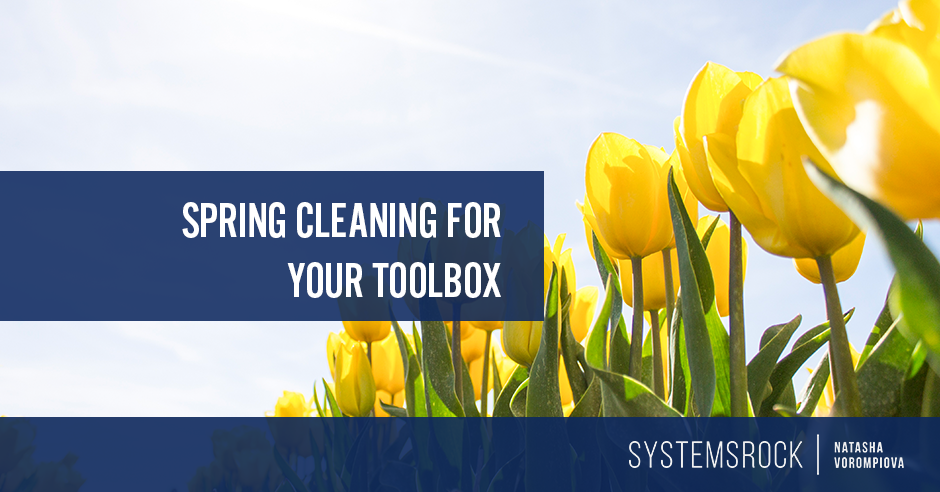It’s springtime–time to clean out the clutter.
Don’t forget to include cleaning out your digital toolbox.
With new tools and services coming out every day, it’s easy to accumulate more than you need.
Avoid getting to the point where your tools and programs hinder your progress by using this checklist to comb through what you’re currently using, what you’re no longer using, and what you really need to optimize your business systems.
Use this Spring Cleaning Checklist for Your Toolbox
1. Take inventory of the tools you’re currently using in your business.
List the tools you’re using for:
- Collecting payments
- Tracking finances
- Scheduling meetings
- Managing clients
- Storing information
- Communicating with your list
- Handling social media
You might also want to take a look at your monthly bank statement, so you don’t miss any charges for tools that are automatically deducted from your account.
You’re not only clearing digital and mental space; you’re also saving yourself money.
2. Write “OK” next to the tools you want to keep.
Set aside 15 minutes this week to examine your favorite tools and make sure that you are using them to their full potential.
For example, you’ll be surprised how Evernote or Asana can help you run your business.
Then, set a date six months from now (and put it on your calendar) to reevaluate your tools and make sure they’re still right for your business.
Your business may have outgrown the tools you were using or your business model may have changed to a point where you need to upgrade or find another tool to replace the old one.
Sticking to what’s tried and true can save you time in the short term, you don’t want to sacrifice long-term effectiveness.
3. Put a question mark next to tools that aren’t wowing you or that overlap in functionality with other tools.
When you’re not clear about the full capabilities of your tools, it’s possible that you may be using three tools that have the capacity to do the same thing.
For example, if you’re not really using your CRM (Client Relationship Management software), but are in love with Evernote or Asana, you can build your own CRM using Evernote or Asana.
When you’re able to find ways to use the tools you already have to get things done, your day-to-day life will feel less cluttered and more streamlined.
4. Mark an “X” next to the tools that you haven’t been using for at least 3 months.
Set aside 15 minutes to unsubscribe from all these tools.
Be very strict with yourself.
If you bought a tool with the intention of using it, but never got around to do it, stop paying for it. Now.
This applies to membership programs that you haven’t had the time to take advantage of.
While you still may have good intentions about diving into them, it’s better to cancel them now and revisit them when you can make space in your schedule to fully commit.
Mark your calendar to sign up again IF by that date you can carve out more time or are still interested.
Use this step for:
- Newsletters
- Who you follow on Twitter, Facebook, Instagram, etc.
Clearing space this way gives you more mental energy to invest in meaningful activities for your business.
5. Identify the tools your business still needs.
List the areas of your business where you waste a lot of time and see if there is a tool to help you manage them.
There are 5 areas in your business that you must automate. Not sure which areas? Check this list to help you automate where you need to.
Before you look for new tools, though, create two lists of must-have and nice-to-have features and see if any of your existing tools can manage that area. Need help? Here is a handy to-do for selecting online tools.
Remember, we’re aiming to spring clean here, so be choosy with what new services or tools you sign up for.
6. Create your Toolbox Wishlist to list the tools you’d love to use in the future.
Set a date 3 months from now (and put it on your calendar) to see if it’s time for you to buy one of those tools (you can do it to reward yourself for accomplishing a goal you’ve set up for yourself)
If you want some inspiration, here is my personal list of tools.
Be Intentional
Be intentional about the tools you select to run your business.
Unnecessary tools can suck up money and time that could be put to better use.
Back To You
Which tools have become absolutely essential in your business? Which ones are you ready to let go of?



Great list and reminder to reevaluate and clear out stagnated items. Love your link references and resources – Thank you.
Thank you, Roxanne! Happy to hear that!! 🙂